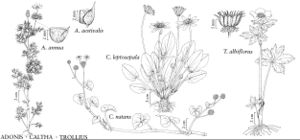Adonis
Sp. Pl. 1: 547. 175.
Gen. Pl. ed. 5, 242. 1754.
| Taxon | Illustrator ⠉ | |
|---|---|---|
 | Adonis annua Trollius albiflorus Caltha natans Caltha leptosepala | John Myers John Myers John Myers John Myers |
Herbs, annual, or perennial from stout rhizomes. Leaves basal and cauline (cauline often absent at flowering time), proximal leaves petiolate, distal leaves sessile; cauline leaves alternate. Leaf-blade 1-3-pinnately dissected, segments narrowly linear, margins entire or with occasional tooth. Inflorescences terminal, flowers solitary; bracts absent. Flowers bisexual, radially symmetric; sepals not persistent in fruit, 5 (-8), nearly colorless or green, plane, obovate, 6-22 mm, apex ± erose; petals 3-20, distinct, yellow to red [white], often striped or basally darkened with black, purple, or blue, plane, oblanceolate, 8-35 mm; nectary absent; stamens 15-80; filaments filiform; staminodes absent between stamens and pistils; pistils ca. 20-50, simple; ovule 1 per pistil; style present. Fruits achenes, aggregate, sessile, nearly globose, sides veined or rugose; beak terminal, straight or strongly curved, 0.5-1 mm. x=8.
Distribution
North America, Eurasia, nAfrica
Discussion
Species ca. 35 (3 in the flora).
Several species of Adonis are frequently cultivated in North America for their showy flowers. In eastern North America the species sometimes escape from cultivation; although they may become briefly naturalized, most populations evidently do not persist. In the western United States A.aestivalis apparently was introduced as a contaminant in agricultural seed and might have escaped from cultivation. It has become naturalized, and populations tend to persist.
Reliance on herbarium specimens, rather than population studies, of annual Adonis in North America has resulted in confused species concepts. Flower color is variable within the species and changes with drying, and diagnostic features of the fruit are reliable only when achenes are fully mature (C. C. Heyn and B. Pazy 1989).
While most Ranunculaceae attract pollinators to often highly specialized floral nectaries, Adonis lacks nectaries, instead offering pollen as a reward. The fruits are harvested by ants.
Leaves and roots are said to be poisonous to humans and livestock.
Selected References
None.
Lower Taxa
Key
| 1 | Herbs perennial; flowers 4–8 cm diam., anthers yellow; achenes pubescent, beak strongly recurved. | Adonis vernalis |
| 1 | Herbs annual; flowers 1.5–3 cm diam., anthers purple-black (olive green with age); achenes glabrous, beak straight or nearly so, erect. | > 2 |
| 2 | Body of achene without transverse flange, abaxial keel not toothed. | Adonis annua |
| 2 | Body of achene with transverse flange (usually most pronounced abaxially), abaxial keel with small tooth at junction with flange. | Adonis aestivalis |